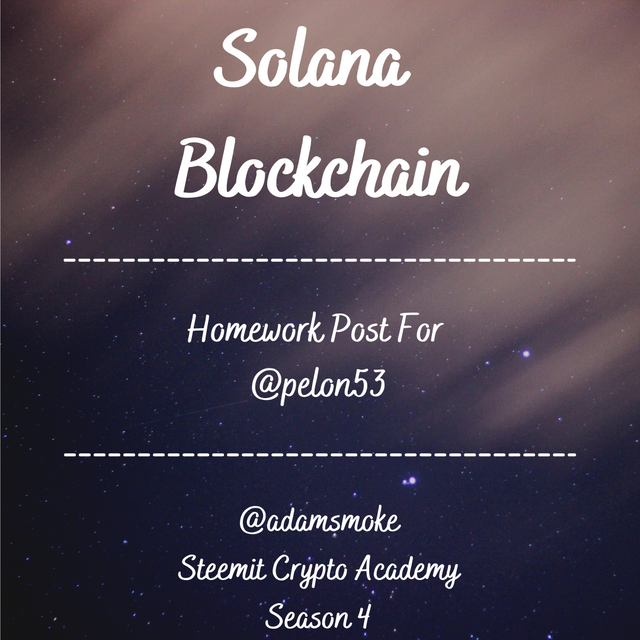
Introduction
Hello to everyone,
In this post, it will be about Solana Blockchain, one of professor @pelon53's lecture series on next generation blockchain projects. Thank you to everyone who reads my post. Let's start.

Question 1
Describe in detail Solana's PoH.
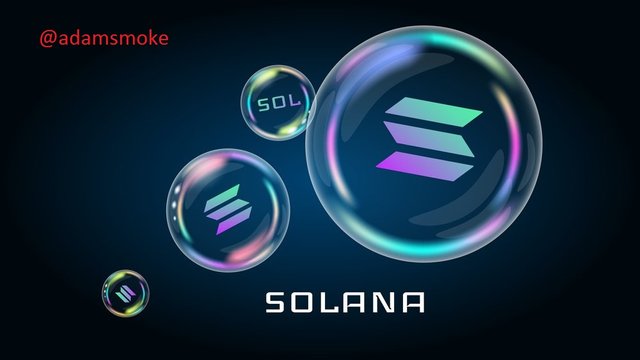
Solana blockchain is a project made to eliminate the scalability and speed problem, which is the biggest problem of blockchain technologies. The first studies of the Solana project were initiated in 2017 by the Geneva-based Solana Foundation, Switzerland. Anatoly Yakovenko and Greg Fitzgerald are at the head of the project. The official launch was made in March 2020 and the SOL token was launched. They conducted public tests on July 19, 2018, before the official opening took place and had good results. However, the Solana project continued these tests and achieved results far above other blockchain projects, bringing a new dimension to speed and scalability. It would not be wrong to say that it has eliminated the speed and scalability problem. Because when we look roughly at the features that the Solana project offers to its users;
- Scalability: Block generation time is 400 milliseconds and can support more than 50,000 transactions per second.
- Decentralization: By using the Solona Turbine block propagation protocol, the platform is able to support thousands of Nodes while maintaining its high performance and scalability.
- Transaction Fee: Approximate Network transaction costs are estimated at 10 USD per 1 million transactions and are quite small.
So how can Solana do this?
Solana has left other blockchain projects far behind in terms of speed and scalability. The Solana project stands out thanks to the innovations introduced and is in the leading position. These innovations; PoH (Proof of History), Tower BFT, Turbine, Golf Stream, SeaLevel, Cloud Break, Replicators, Pipelining. One of the factors that played a role in Solana's current position is the PoH (Proof of History) algorithm, which is among the innovations it brought. Now we can briefly talk about this algorithm.
Proof of History (PoH)
The PoH algorithm was developed by the Solana blockchain network. If you ask the difference of PoH from the algorithms used by other blockchains;
For example: Bitcoin, etc. Many blockchain networks use the Proof of Work consensus mechanism. In this algorithm, the system works as follows:
Before the blocks on the Bitcoin network are verified; They are unordered and are found in large groups. Each Miner adds a time and date in local time to the block it has verified (Excavated). There are errors that may occur because there may be differences between the nodes that add time and date stamps to the blocks according to the local time. Nodes communicate with all nodes to determine whether the timestamps of these blocks are correct. Meanwhile, a lot of time has passed.
PoH, on the other hand, brings a radical solution to this situation and saves the Hash values of its transactions in a sequential manner. We all know that the hash value is unique, so when the new Hash is generated it is stamped with the previous hash value. Thanks to this feature, there is a hash data history and less data is processed and transmitted while blocks are created. In this way, the confirmation time of new blocks is considerably shortened.
During the approval process of the blocks, Solana uses the Tower BFT system developed by the Solana team. The Tower BFT system is an improved and revamped version of Practical Byzantine Fault Tolerance (PBFT).
Solana has managed to become the fastest blockchain by combining these two systems. When using PoH and Tower BFT together; PoH generates global times. PBFT then uses a synchronized timestamp for each node to check, verify and confirm transactions at each node, provided the parameters generated according to the network protocol are provided. In this way, it prevents errors and delays arising from the local time difference. In short, we can say that it is a cryptographic clock used to achieve consensus of blocks.
Thanks to this method, Solana can work quickly without the need for large data loads and processing delay.

Question 2
Describe at least 2 examples of solana use.
Serum (SRM)
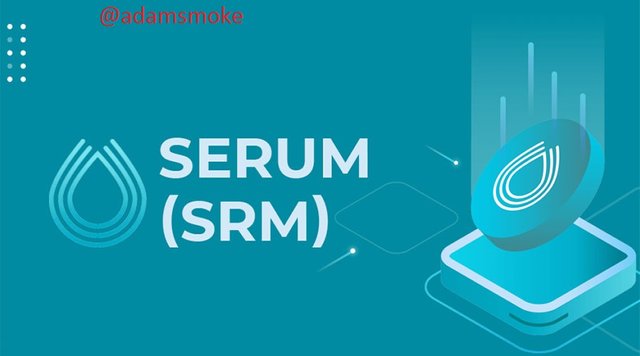
Serum is a decentralized cryptocurrency exchange built on the Solana Blockchain. Serum can work with multiple cryptocurrencies (including Bitcoin, Ethereum). The serum was developed with Sam Bankman-Fried and members of the FTX team.
The serum is characterized as the last point of DeFi. Serum is a pure DeFi project. It is completely reliable thanks to its decentralized structure and uses a decentralized Order Book. In this way, Serum becomes a scalable and fast system.
It is completely decentralized up to the serum core protocol. Thanks to this feature, users do not need any identity information and are based on confidentiality while performing cross-chain trade.
Since Serum works with Solana and Ethereum, it can also work with ERC20 tokens.
SRM Token
The Token of the serum project is called SRM.
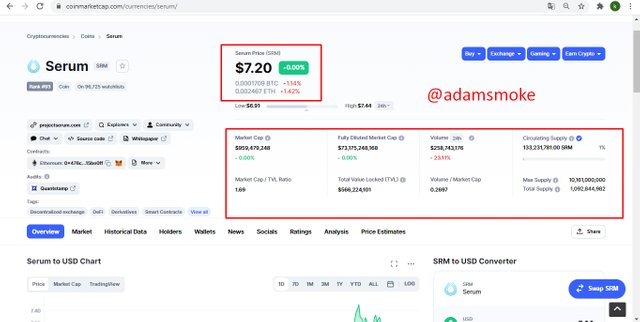
- As you can see in the screenshot above;
Serum Price: 7.20 USD
Market Cap: 959,479,248 USD
Volume 24H: 258,743,176 USD
Raydium (RAY)
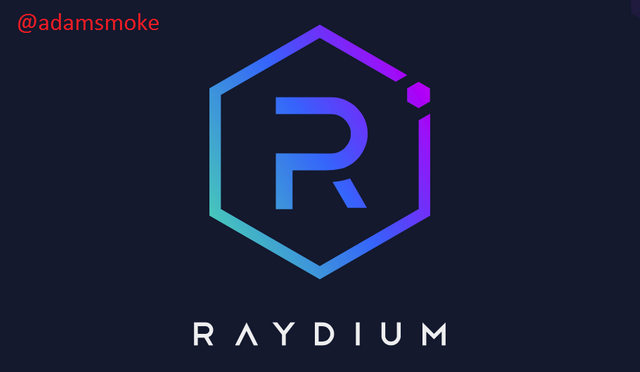
RAY is built on the solana blockchain and is an Automated Market Maker (AMM) as well as a liquidity provider, leveraging the innovations of the Serum project. If we explain in the most general definition; It is a platform built on Solona Blokzicniri, which operates with a centralized order book and on-chain liquidity. Provides fast and trouble-free trading of Serum DEX. Although Solona is built on the blockchain, it also works with Ethereum.
The Token of the Raydyum project is RAY. RAY has a maximum supply of 550,000,000 tokens. This makes it easier to procure than other tokens.
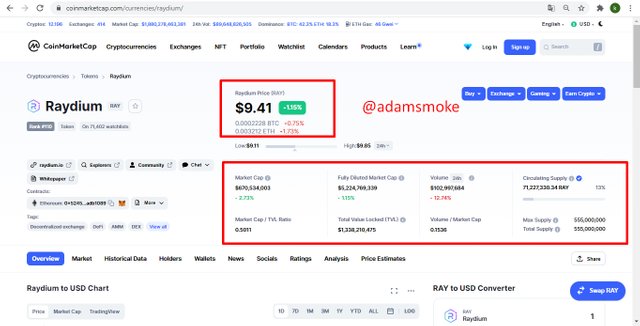
- As you can see in the screenshot above, RAY Token's Coinmarketcap data:
Radium Price: 9.41 USD
Market Cap: 670,534,003 USD
Volume 24H: 102,997,684 USD

Question 3
Detail and explain the LEFT token.
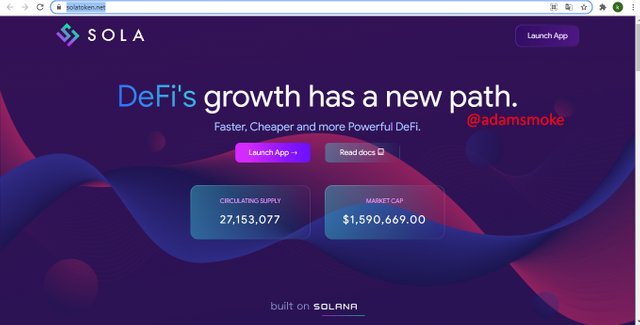
Sola Token is a DeFi project built on the Solona network. It is a platform that combines the features of Centralized (CEX) and Decentralized (DEX) systems. Sola Token is a Token of the Solatoken.net platform.
Sola Token uses the AMM algorithm and offers us a liquidity pool. Sola token works with Serum DEX, which like many projects is built on the Solana blockchain. Features found in the serum; Features such as being able to work with ERC20 tokens compatible with Ethereum and Order Book used in the Serum project are also available on Sola Token.
It is not a very popular Token at the moment, so it is still not listed on many platforms. However, the market situation that I access via the Coingecko platform is as follows.
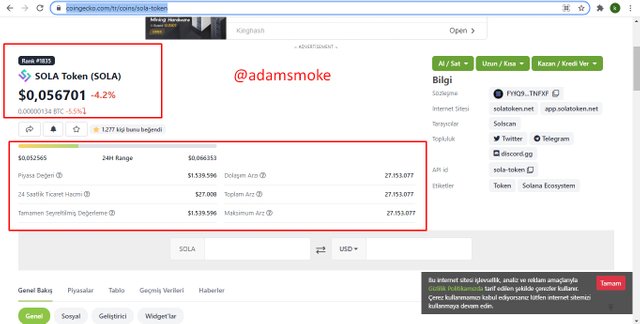
Sola Price: 0.056701 USD
Market Value: 1,159,596 USD
Volume 24H: 27.008 USD
Max Supply: 27,153,077 USD
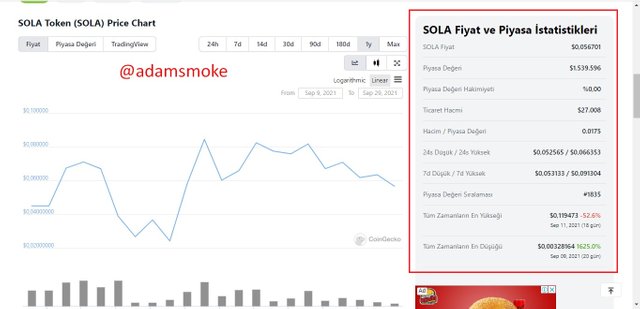
- As you can see in the screenshot above, Sola Toke has a price chart that fluctuates nicely.
- Again as can be seen on the right side of the screenshot:
Market Value Ranking: 1835
All-time High: 0.119473 USD
All-time Low: 0.00328164 USD

Question 4
When did Solana Blockchain see its operations get interrupted? Why? Explain.
The Solana Blockchain network suffered a 17-hour outage on September 14, 2021, lasting almost 1 day. However, after a very long time, it returned to its full functionality again.
The main factor that caused the network to crash and stop was that it was facing a denial of service attack. At exactly 12:00 (UTC), the attack launched the Grape Protocol IDOs on Raydium. During this process, bots filled the network by generating a large number of transactions. This transaction density caused many nodes to crash and caused the network to slow down gradually and then to a complete stop. In short, the bots caused a memory overflow in this attack. For this reason, the nodes could not reach an existing agreement on the blockchain and the network went offline. Therefore, the network is prevented from confirming new blocks.
Later, after the situation was diagnosed, the community made a vote that required 80% approval of the nodes to reach an agreement, and then requested a hard fork of the network. Then many engineers and validators worked together to restart the network. Afterwards, the network was restarted and opened at 05:30 (UTC).
Solana shared the instant sharing of these events with its users on its official twitter page.
Here are the times when the first problems started;
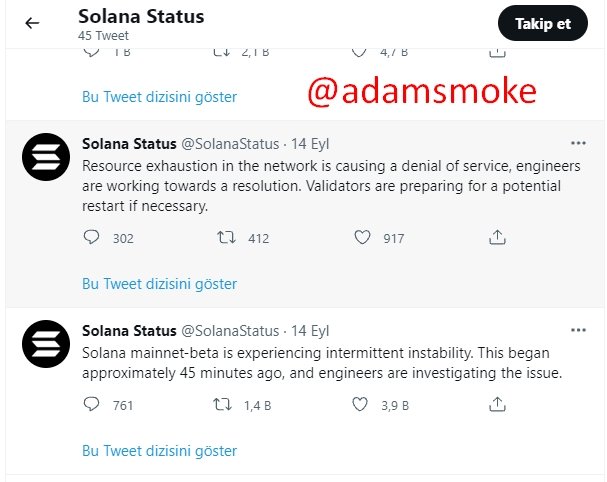
- As you can see in the screenshot above, Solana network initially announced that transaction confirmations could not be made intermittently and exhaustion in the network caused denial of service.
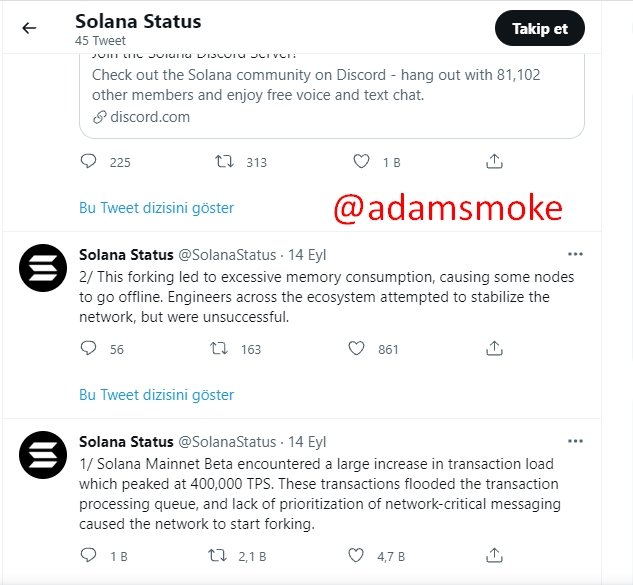
- Later, he announced on twitter that the transaction load reached up to 400,000 TPS and prevented the network from working properly, causing forking. He explained that forking on the blockchain caused excessive memory consumption, some nodes went offline and their efforts to fix this situation were unsuccessful.
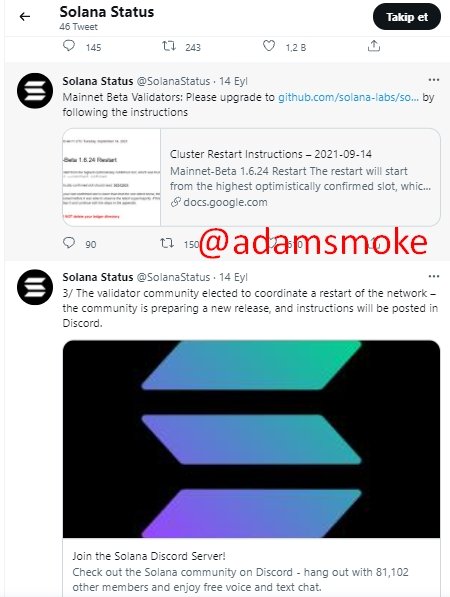
- After failing, they started work to restart the network without wasting time and started to do this by giving instructions over the discord group.

- Later, the validator community upgraded the system to 1.6.25, allowing the network to restart and announced that the system will return to normal operation in a few hours.
Although Solana is currently the fastest blockchain, each network has certain limits. This issue still arose despite many tests for the solana project. However, the Solana team managed this issue very well and resolved it within 24 hours. This caused an extra drop for the Solana project and its token for a certain period of time. However, in my opinion, I think that the price of the project will increase even more in the future due to its features such as being good and beautiful, making good partnerships and agreements.

Question 5
Check the last block created in Solana and approximate how many blocks are created per second from the first block to available in Solana? Justify your answer and show screenshots.
In this section, we first check the last block created by going to the Solona Explorer platform.
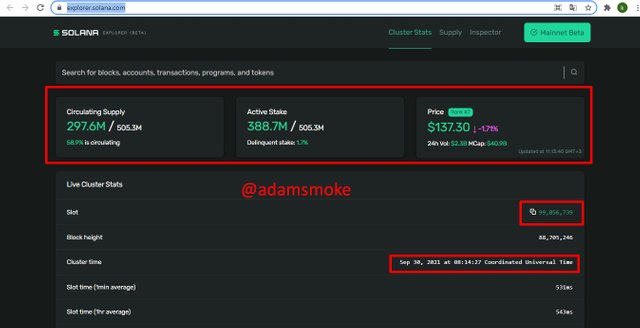
- When we first open the platform, a section with brief information about Solona welcomes us. (Circulating Supply, Active Stake, Price)
- Then there is the information of the blocks created instantly.
- In this section, as you can see, I can see the block number 99.056.739 and the timestamp (30 Sep 2021 at 08:14:27).
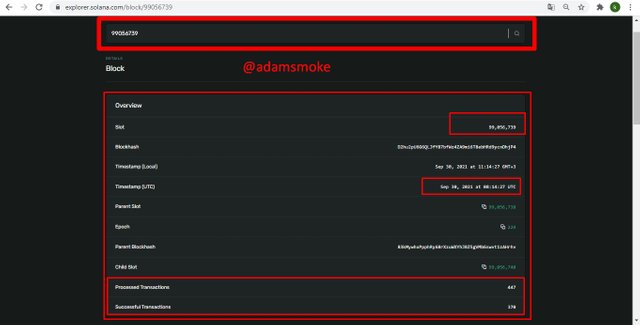
- Later, we can get more detailed information about the block by typing the block number in the search section.
- We can see the timestamp of this block, hash values, the number of transactions and the number of successful transactions in detail.
- In this block, 447 transactions were made and 370 of them were successful.
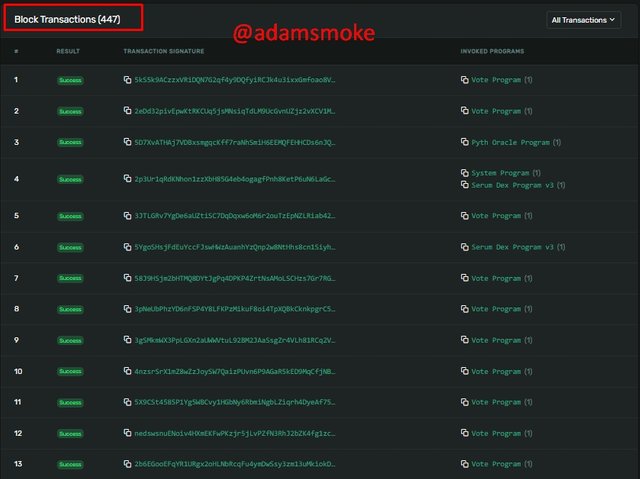
- Later, when we scroll down a little bit on the page, we can see all the transactions that took place on the block.
Then, we examine our blog on the solscan platform.
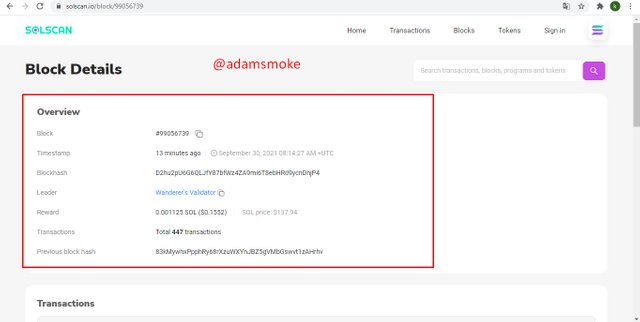
- As we can see in the screenshot above, we can access all information about the block from this platform.
I then search for Block 1 (Genesis Block).
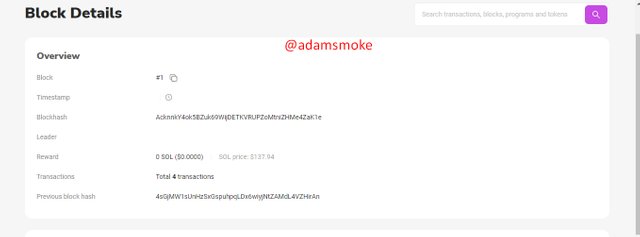
- As you can see in the screenshot above, there is no timestamp for the Genesis block.
According to the information released by the Solana team, Solana has a speed of producing 1 block in 0.5 seconds. If we make a calculation based on this information;
- (99056739) x (0.5) = 49528369.5 seconds.
Then we can do mathematical operations to calculate this time in months or we can easily do this on many platforms.
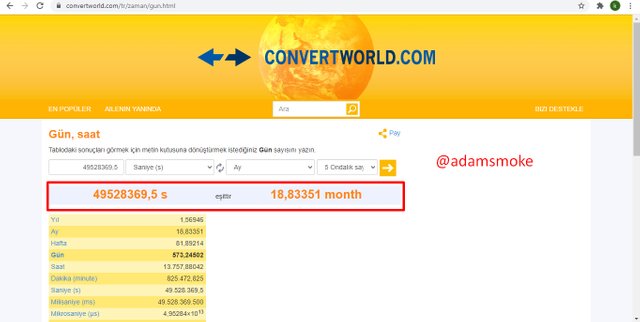
- As you can see in the screenshot above, the time since the first block is 18.8 months.
Considering that the Solana platform started working in March 2020, it has been approximately 19 months. As our calculations overlap, we can confirm the definition that the Solana network produces 1 block per 0.5 second.
When we make a short calculation, Solana network;
Per Second: 2 Blocks
Per Minute: 120 Blocks
Per Hour: 7,200 Blocks
Day: 172,800 Blocks
Monthly: 5.184,000 Blocks
Yearly 62,208,000 Blocks
We can say that it has the capacity to produce.

Conclusion
Solana blockchain technology ranks first among new generation blockchains in terms of speed and scalability. We tried to explain the reasons and reasons for this clearly in this post.
Although there are huge differences in transaction speed and scalability with other blockchain projects, we have seen with the collapse of the Solana network that every blockchain network can experience density.
For this reason, it should not be forgotten that there can always be problems in blockchain technology. However, we should not forget that these problems cause a continuous development.
Thank you professor @pelon53 for this beautiful and wonderful lesson and everyone who read my post. I wish you all a healthy and beautiful day.